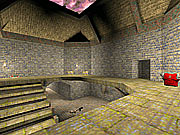

A1. Map Retexturing
Use the standard Quake maps to retexture; don't use the ones included in SynQ for now.
Every Quake map has textures compiled in the .BSP. These textures reside a WAD file (.wad) and are compiled into the map with QBSP. They can be extracted with BSP2WAD. Wad files can be viewed by a WAD editor, TexMex and Wally being the 2 that seem to be used the most often.
The Quake Palette (the bottom 2 rows, rows 15 and 16 or colors 224 thru 256, are fullbright colors)

You can also rewad a map using UPDBSP (download from QuakeTerminus), which will update the .bsp with the new 8-bit textures for, in particular, WinQuake style engines. To get a map out of the Quake pak0.pak or pak1.pak, use Pakscape and drag, say, dm6.bsp from pak1.pak (maps folder) to a Windows folder.
In TexMex, if you plan on importing textures for compiling/rewadding into a map, do View -> Preferences and turn fullbright conversion OFF, otherwise you will have fullbright pixels where you don't want them!

The textures in Quake maps are limited the 256 colors (8 bit color) in the Quake palette, but TexMex can import a 24 bit image either via the clipboard and make it fit the palette (although sometimes it will look greatly different).
WAD textures:

c:\quake\id1\textures external textures

Result:

External Textures
Can be used by all modern engines, supports 24 bit color using .tga (preferred because it is the fastest!) or .jpg or .png.
External textures generally go in c:\quake\id1\textures folder and have the same name as the texture in the WAD file, except for textures beginning with * must be changed to # (*teleport in wad must be #teleport.tga as an external texture).
These are sometimes referred to as the diffuse color textures.
Special External Textures
LUMA/full bright. External textures can be created that have a fullbright (fullbright: glowing, unaffected by lighting so it is visible even in complete darkness) component using _luma or _glow. _luma is the more supported naming convention and will be the one used for this.
The pixels should be black on the base external texture because the _luma layer is added to the base texture (an additive blend).
Check out the Quake Retexturing Project to get an idea of how this works -- you will see _luma.tga files in the download that contain the fullbright component.

Bump Mapped. Bump mapped textures giving the appear of height and depth can be created. When playing multiplayer, you really aren't going to notice this too much but this can be used to add detail to textures. This wikipedia article explains this well. For more information, really one great source is to read this thread and download the pack. DarkPlaces supports this feature; I'm not 100% certain about which other engines do.
Map Modification
This is another option available to "remake" the maps.
These maps must be physically compatible with the ID originals in all ways for the purpose of the project, but nothing prevents us from splitting up some of the brushes to introduce new textures into a map -- say, adding a painting or banner on the wall of a map or putting some logos on floors or adding trim to a wallway.
Additionally, the texture names can be altered to make it so 2 areas of a map that use the same texture can be changed so, say, stairs and a platform that previously had the same texture can use different ones.
The maps can edited in Worldcraft 1.6 (docs | download) (don't use Worldcraft 3.3) and compiled using qbsp/light/vis on them.
Map modification will be further down the road, I don't want to spend too much time on this now.
More references:
QuakeOne Navigator
The Quake Wiki
aguirRe's home page
Func_Msgboard (Quake Map Development site)

Comment